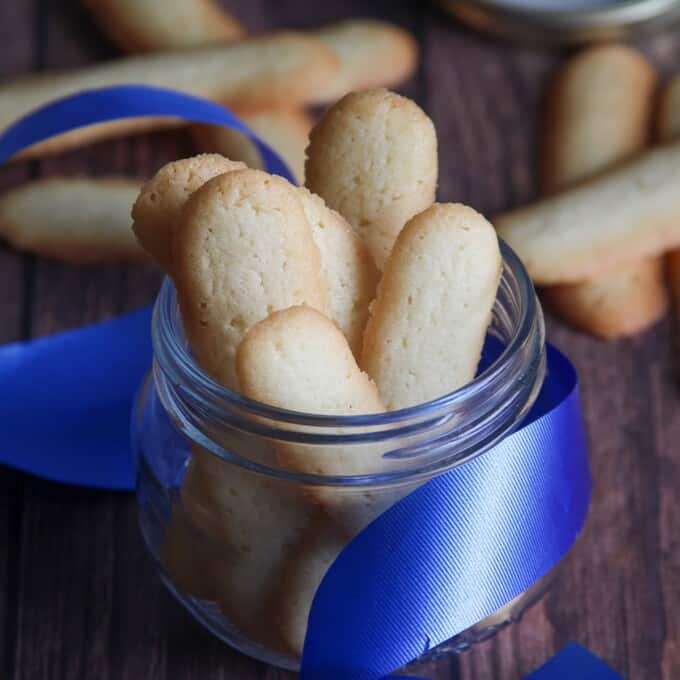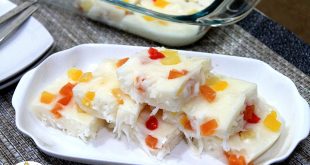Brazo de Mercedes or Mercedes Arm is a classic Filipino dessert made of fluffy meringue and creamy yema filling. Give the recipe a try; it’s easier to make than you think!
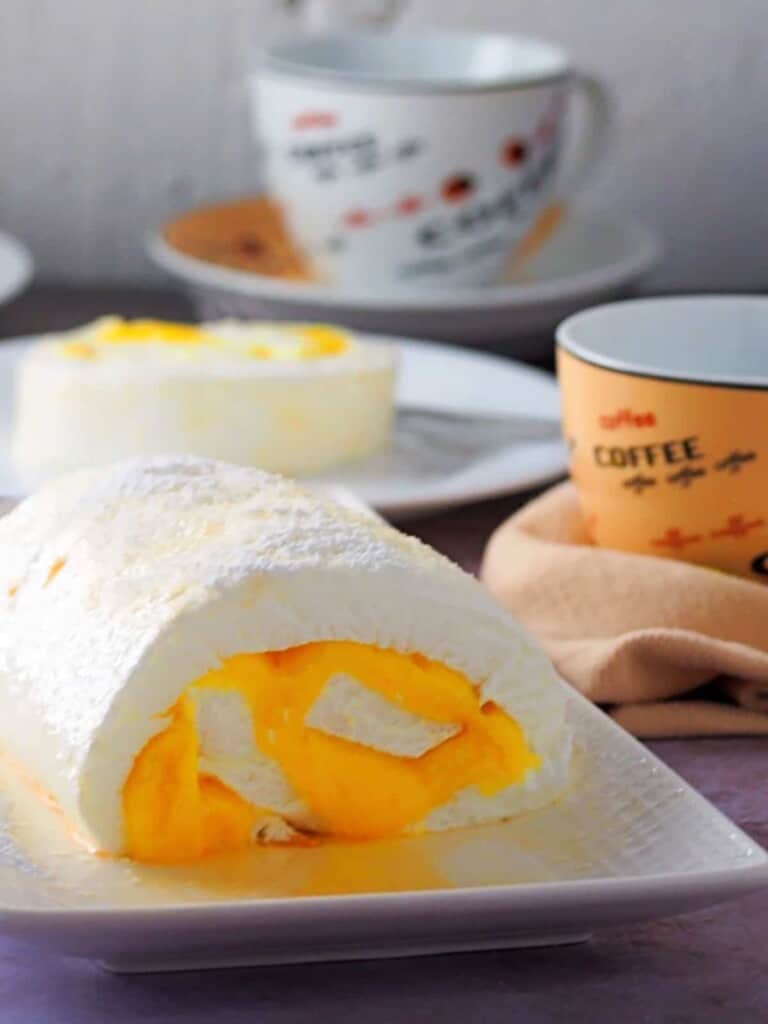
Brazo de Mercedes is a jelly roll made with a pillowy meringue wrapped around a rich custard filling. Also called Mercedes’ arm, this Filipino dessert dates back to Spanish colonial times when builders used egg whites for mortar and plaster, and cooks turned egg yolks into various delicacies such as yema to prevent waste.
Yema ingredients
- Egg yolks– separate the yolks from the whites while the eggs are still cold because the yolks are firmer and are less likely to break. However, bring the egg whites to room temperature before beating into a meringue for better volume.
- Sweetened Condensed milk– cook with the yolks to make the custard filling
- Vanilla extract– enhances flavor
- Lime or lemon zest– cuts through the richness, adding a hint of citrus flavor
Meringue ingredients
- Egg whites– while the eggs are easiest to separate when cold, it’s best to have the egg whites at room temperature when beating into a meringue for better volume
- Cream of tartar– stabilizes the egg whites, helps the meringue hold shape, and prevents weeping.
- Superfine sugar– also called caster or ultrafine sugar; this sugar works best for meringue as the granules dissolve quicker, preventing overbeating, and dissolve better, leaving no gritty texture
- Powdered sugar– also known as icing or confectioner’s sugar
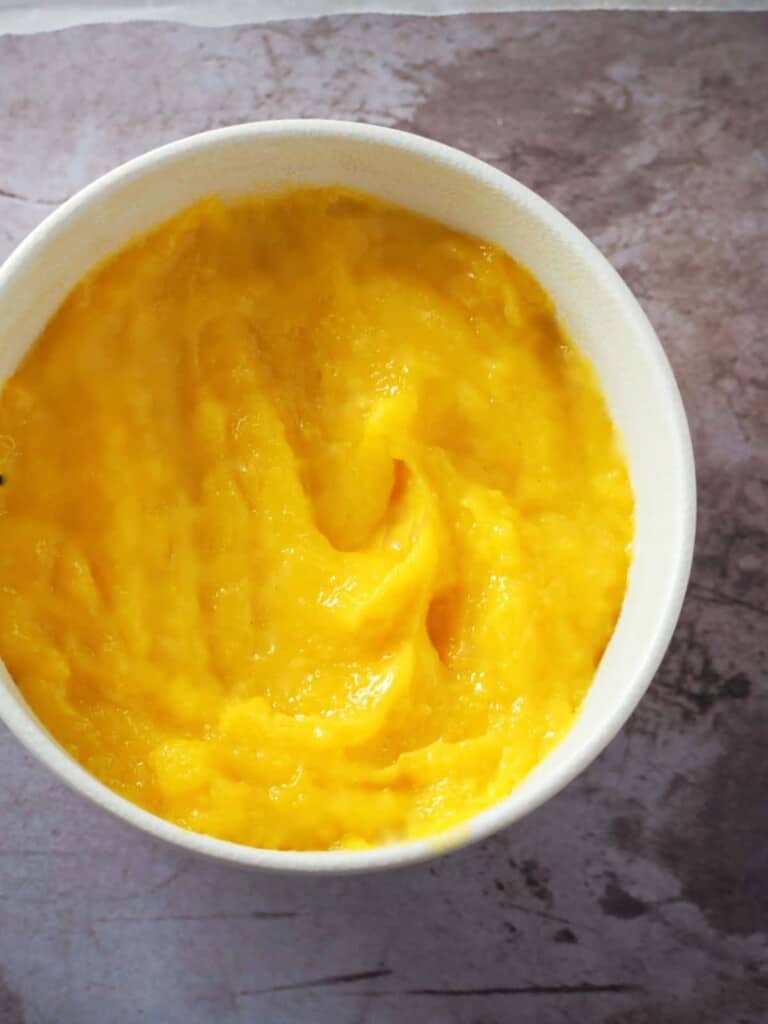
Brazo de Mercedes has two components, the meringue, and the yema filling. It might seem like a highly complex recipe, but it’s actually a pretty simple cake to make.
Just read the tips and guidelines in the post, and you’ll breeze through the process like a pro.
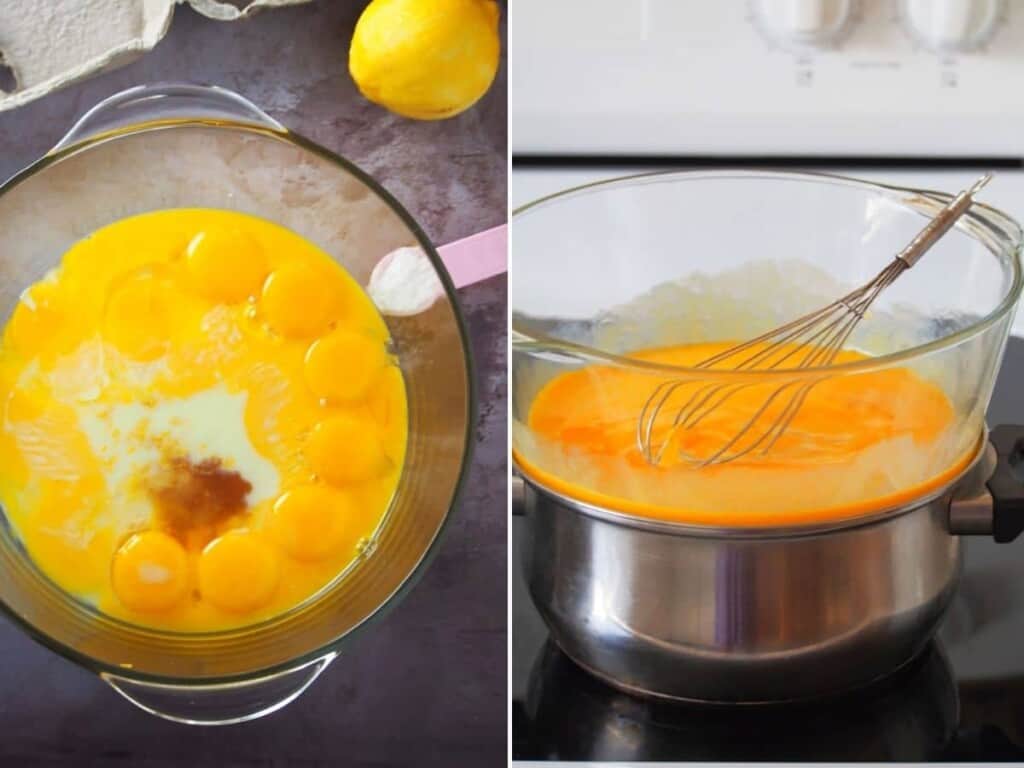
Making the yema
- Combine the ingredients until well-blended BEFORE placing on the flame as the heat can cook the yolks into scrambled eggs and turn the mixture lumpy.
- For a silky and smooth texture, cook the custard mixture low and slow. High heat can curdle the yolks.
- Tend to custard and stir regularly to prevent lumps. Cook in a double boiler for a gentler heat.
- Cook the custard until thick but spreadable. Remember that the mixture will continue to thicken as it cools.
- Lightly press plastic film on the surface of the cooked yema to keep from drying out.
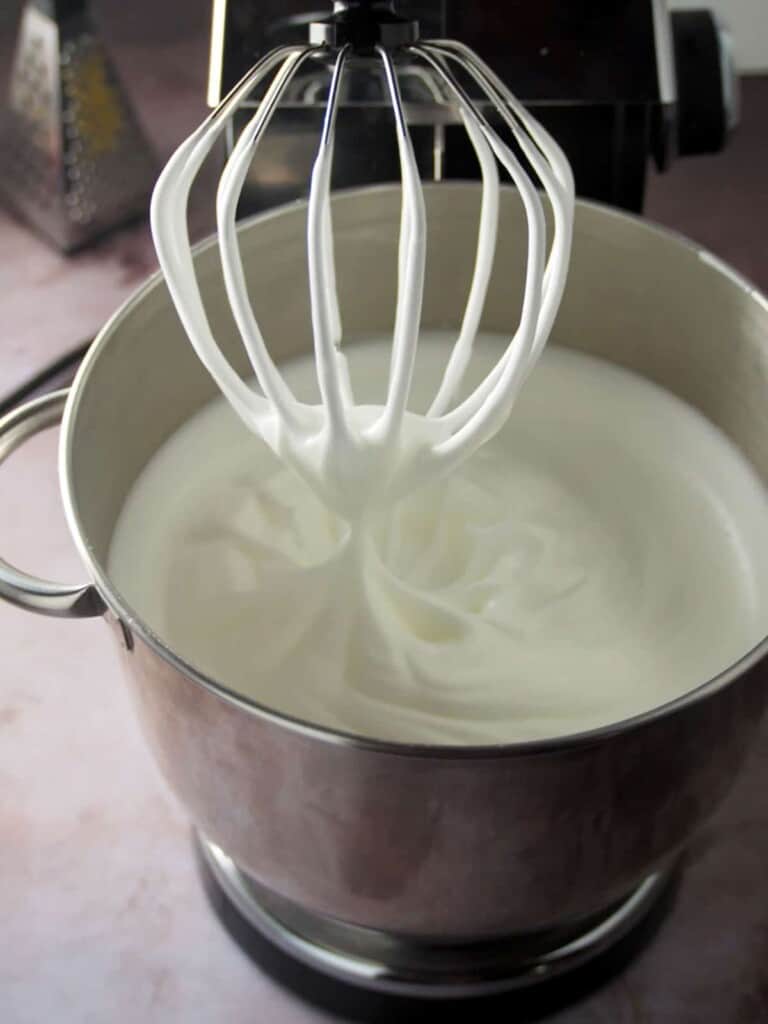
Making the meringue
- Older egg whites create more volume but fresh eggs have a more stable foam.
- Let egg whites stand at room temperature for about 30 minutes before beating for maximum volume.
- Avoid aluminum bowls as they can turn egg whites to gray or plastic bowls which usually have hidden traces of fat or grease that can spoil the meringue and keep it from stiffening up. Chefs prefer to use copper bowls as the chemical reaction between copper and the egg whites produce a more stable foam, but if you don’t have one, stainless or glass bowl are ok to use.
- Use very clean and dry bowls and beaters. Fats or any residue can affect the eggs’ volume and cause the meringue to deflate.
- Make sure no traces of yolk get into the whites as they will not expand properly. Crack the eggs on the counter and not on the edge of the bowl to reduce the chance that a shard of the shell will puncture the yolk.
- Add the sugar gradually to the egg whites so they don’t lose volume.
- Do not overbeat! You know they have reached stiff peaks when the whipped whites no longer slide around when the bowl is tilted. Properly-whipped egg whites should look shiny and moist.
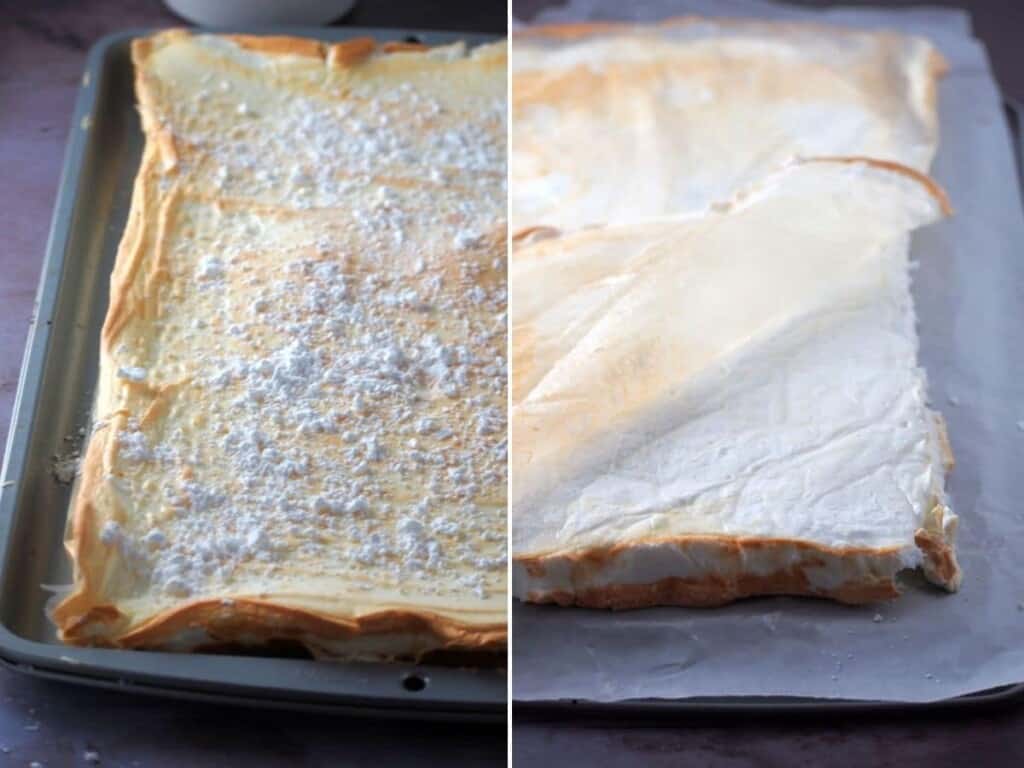
Important FAQ
Here are a few questions and answers to help you troubleshoot.
Why Did My Meringue Deflate?
- Sugar not only sweetens the meringue but also gives it a sturdier structure. Use superfine sugar and add to the egg whites gradually.
- Beating the egg whites too quickly or too high a speed can form unstable air bubbles which can collapse. Whip the egg whites at low speed until they become foamy then increase to medium speed.
- The acidic cream of tartar helps create a more stable foam. Add cream of tartar or an acid such as lemon or vinegar to help the meringue hold shape and to keep from weeping.
Why Did The Top Crack During Baking?
- The egg whites were probably beaten at a high speed. Whisk at medium speed with an electric mixer.
- The meringue was baked at a high temperature or cooled too quickly. To prevent cracks, leave the meringue in the oven (turned OFF) after baking to slowly cool.
What Causes Beading?
- Beads of moisture may sometimes form on the surface of the baked meringue and this often results from overcooking. Check the meringue at the minimum baking time to prevent over baking.
- Sugar hasn’t fully dissolved before baking which can melt and seep out on the surface. Use caster or superfine sugar as the tiny crystals dissolve quicker. Add the sugar gradually and not all at once during whipping to give it time to dissolve. Check the meringue with your fingers to feel for any grittiness.
What Causes Weeping?
- Liquid can seep out of the meringue and pool at the base, and this usually results from overwhisking the egg whites.
- Underbaking can also cause the baked meringue to weep as there is too liquid left in the meringue. Check if the meringue was baked completely; you should be able to lift it from the tray without sticking.
- Cornstarch helps stabilize the meringue and prevents weeping by absorbing the excess liquid. A tablespoon of cornstarch mixed with the sugar can be helpful, especially in hot, humid weather whent there’s extra moisture in the air.
Baker Hacks
- Don’t have caster sugar? You can easily make some by running granulated sugar in a food processor or blender until super fine!
- To make decorative ridges, run a pastry comb, serrated knife or the tines of fork crosswise on the surface of the meringue before baking.
- Use a fine-mesh to sprinkle the powdered sugar.
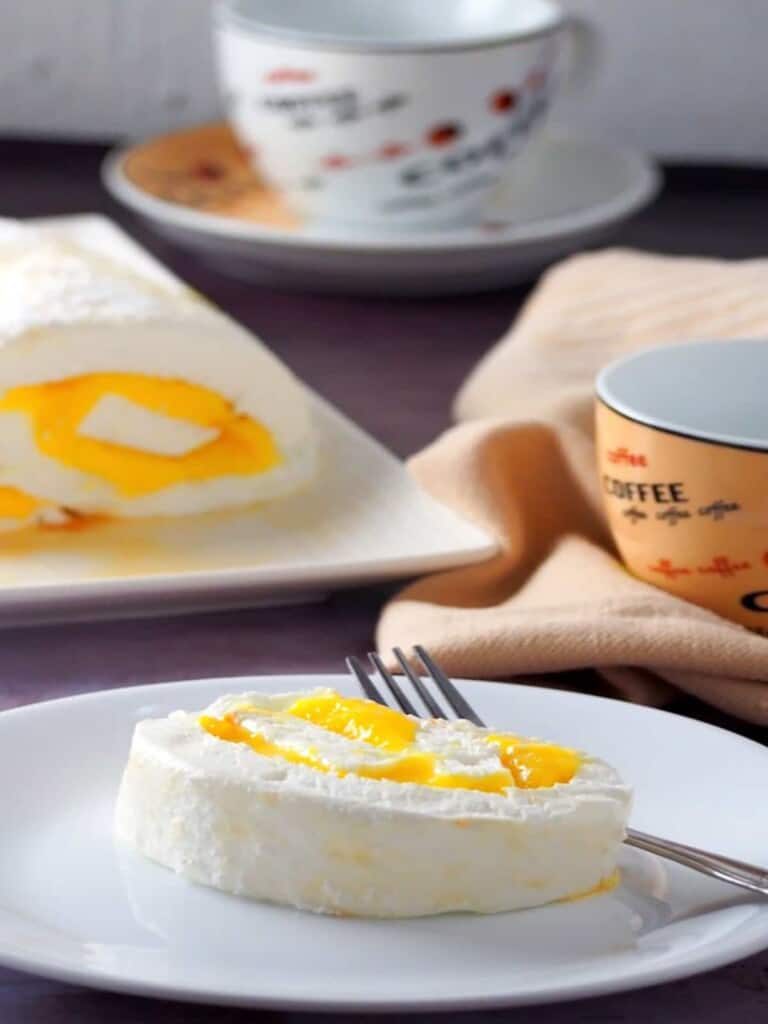
How to serve and store
- Brazo de Mercedes is a delicious dessert that’s sure to impress. Allow to cool completely and slice into serving portions to enjoy.
- To store, cover the ends of the roll with wax paper to keep from drying out. Place in a cake box or container with a lid and refrigerate.
Did you make this? Be sure to leave a review below and tag me @kawalingpinoy on Facebook and Instagram!
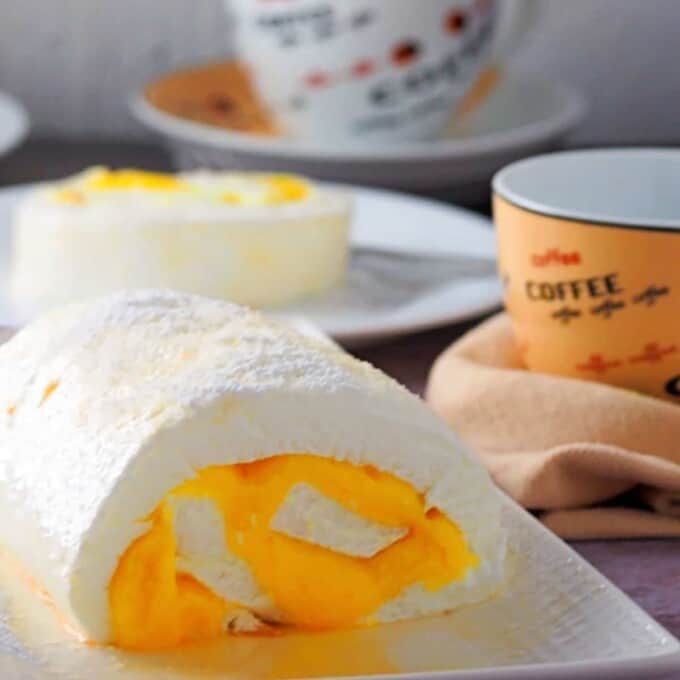
Brazo de Mercedes
Ingredients
For the Custard Filling
- 10 egg yolks, beaten
- 1 can (14 ounces) condensed milk
- 1 teaspoon vanilla extract
- 1/2 teaspoon lemon or calamansi zest
-
In a bowl, combine egg yolks, milk, vanilla extract, and lemon zest. Stir until well-blended.
-
Place in a double boiler and cook, stirring regularly, for about 30 to 40 minutes or until mixture thickens into a spreadable paste. Transfer custard into a bowl and cover with wax paper until ready to use.
-
In a bowl, combine egg whites and cream of tartar. Using an electric mixer, beat at low speed.
-
As the egg whites start to turn opaque and begin to fluff into a thick foam, gradually add the sugar in small amounts and continue to beat while gradually increasing the speed of the mixer until stiff peaks form. The whipped whites will be smooth and glossy, with no sugar grains.
-
Line a 14 x 16 baking sheet with parchment paper and lightly grease the surface of the paper. Set aside.
-
Transfer meringue onto the prepared baking sheet and, using a spatula, spread evenly across into about 1/4-inch thick.
-
Bake in a 350 F oven for about 20 minutes or until the meringue is set and the top has turned light brown. Remove from oven and allow to cool.
-
Using a fine-mesh sieve, light dust top of the meringue with powdered sugar.
-
Place another layer of greased wax paper and another baking sheet over the meringue. Gently invert the meringue onto the new baking sheet and peel the wax paper on top.
-
Spoon custard on top and spread evenly on the cooked meringue, leaving about 1/4 without filling.
-
Starting on the filled side, carefully roll meringue into a log. Cover both ends of the Brazo de Mercedes with wax paper and chill in the refrigerator for about 1 hour.
-
To serve, cut into desired thickness.
 Channa Mereya Desi Serial All Episodes Watch Online – ChannaMereya.Com
Channa Mereya Desi Serial All Episodes Watch Online – ChannaMereya.Com
